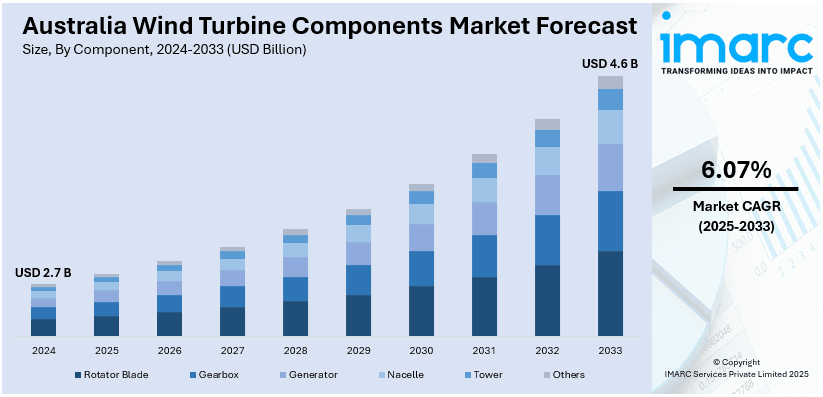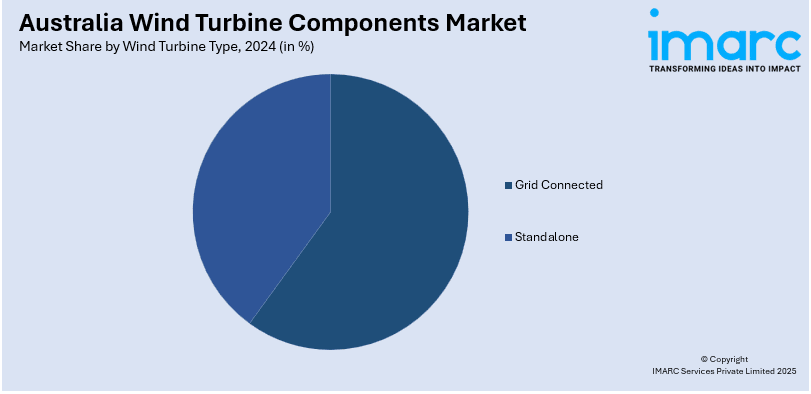
Australia Wind Turbine Components Market Size, Share, Trends and Forecast by Component, Wind Turbine Type, Wind Farm Type, and Region, 2025-2033
Australia Wind Turbine Components Market Overview:
The Australia wind turbine components market size reached USD 2.7 Billion in 2024. Looking forward, IMARC Group expects the market to reach USD 4.6 Billion by 2033, exhibiting a growth rate (CAGR) of 6.07% during 2025-2033. The market is driven by the growing focus on renewable energy sources owing to concerns regarding climate change and environmental degradation, implementation of government incentives and policies, and technological advances, such as longer, lighter turbine blades.
|
Report Attribute
|
Key Statistics
|
|---|---|
|
Base Year
|
2024 |
|
Forecast Years
|
2025-2033
|
|
Historical Years
|
2019-2024
|
| Market Size in 2024 | USD 2.7 Billion |
| Market Forecast in 2033 | USD 4.6 Billion |
| Market Growth Rate 2025-2033 | 6.07% |
Australia Wind Turbine Components Market Trends:
Growing Demand for Renewable Energy
The growing focus on renewable energy sources is impelling the growth of the market in Australia. As fears regarding climate change and environmental degradation continue to escalate, Australian governing agencies and private sector are investing heavily in renewable energy. Australia's aggressive targets for renewable energy, which will get the country to net-zero emissions by 2050, are playing a significant role in spurring the growth and adoption of wind energy as a part of its energy portfolio. The development of large-scale wind farms throughout Australia, especially in areas with good wind conditions, is driving fuel demand for renewable energy-related components. With more wind farms being built, there is a high demand for high-tech and efficient wind turbine equipment, such as blades, towers, nacelles, and other vital parts. Moreover, according to an article published by Clean Energy Council, in total, 4346 MW of new generation capacity was approved in Australia for construction during 2024 valued at over $9 billion of capital investment, along with more than 10,000 jobs in construction.

To get more information on this market, Request Sample
Government Policies and Incentives
Government incentives and policies are contributing to the growth of the market. A number of federal and state-level policies are aimed at facilitating the construction of renewable energy infrastructure, including wind energy initiatives. In 2024, Australia invited bids for 6 GW of renewable energy projects comprising wind and solar projects in Australia’s National Electricity Market (NEM). Moreover, government-backed subsidies, tax credits, and grants for wind energy projects offer monetary benefits to both large-scale and small-scale wind power projects. These policies, apart from making wind power more economically attractive, also ensure good market conditions for the purchase of wind turbine components. With increased government assistance, more investments in the domestic wind turbine production industry is seen, thereby solidifying the market for turbine components.
Technological Advancements in Wind Turbine Design
Technological innovations in wind turbine technology are another essential driver of the Australian market. New wind turbines are growing bigger, more efficient, and more able to produce greater levels of electricity. Technological advances, such as longer, lighter turbine blades, more efficient gearboxes, and better control systems are dramatically enhancing the performance and value for money of wind farms. These developments are positioning wind power as a more viable and dependable source of energy, prompting additional investments in turbine parts. Moreover, the application of digital technologies, such as artificial intelligence (AI) and predictive maintenance software, is improving the efficiency of wind turbines in use, lowering downtime and increasing component lifespan. Such advancements in technology are providing opportunities to domestic manufacturers for producing sophisticated turbine components. The IMARC Group predicts that the Australian AI market size is expected to reach USD 7,761.0 Million by 2033.
Australia Wind Turbine Components Market Segmentation:
IMARC Group provides an analysis of the key trends in each segment of the market, along with forecasts at the region level for 2025-2033. Our report has categorized the market based on component, wind turbine type, and wind farm type.
Component Insights:
- Rotator Blade
- Gearbox
- Generator
- Nacelle
- Tower
- Others
The report has provided a detailed breakup and analysis of the market based on the component. This includes rotator blade, gearbox, generator, nacelle, tower, and others.
Wind Turbine Type Insights:

- Grid Connected
- Standalone
A detailed breakup and analysis of the market based on the wind turbine type have also been provided in the report. This includes grid connected and standalone.
Wind Farm Type Insights:
- Onshore
- Offshore
A detailed breakup and analysis of the market based on the wind farm type have also been provided in the report. This includes onshore and offshore.
Regional Insights:
- Australia Capital Territory & New South Wales
- Victoria & Tasmania
- Queensland
- Northern Territory & Southern Australia
- Western Australia
The report has also provided a comprehensive analysis of all the major regional markets, which include Australia Capital Territory & New South Wales, Victoria & Tasmania, Queensland, Northern Territory & Southern Australia, and Western Australia.
Competitive Landscape:
The market research report has also provided a comprehensive analysis of the competitive landscape. Competitive analysis such as market structure, key player positioning, top winning strategies, competitive dashboard, and company evaluation quadrant has been covered in the report. Also, detailed profiles of all major companies have been provided.
Australia Wind Turbine Components Market Report Coverage:
| Report Features | Details |
|---|---|
| Base Year of the Analysis | 2024 |
| Historical Period | 2019-2024 |
| Forecast Period | 2025-2033 |
| Units | Billion USD |
| Scope of the Report | Exploration of Historical Trends and Market Outlook, Industry Catalysts and Challenges, Segment-Wise Historical and Future Market Assessment:
|
| Components Covered | Rotator Blade, Gearbox, Generator, Nacelle, Tower, Others |
| Wind Turbine Types Covered | Grid Connected, Standalone |
| Wind Farm Types Covered | Onshore, Offshore |
| Regions Covered | Australia Capital Territory & New South Wales, Victoria & Tasmania, Queensland, Northern Territory & Southern Australia, Western Australia |
| Customization Scope | 10% Free Customization |
| Post-Sale Analyst Support | 10-12 Weeks |
| Delivery Format | PDF and Excel through Email (We can also provide the editable version of the report in PPT/Word format on special request) |
Key Questions Answered in This Report:
- How has the Australia wind turbine components market performed so far and how will it perform in the coming years?
- What is the breakup of the Australia wind turbine components market on the basis of component?
- What is the breakup of the Australia wind turbine components market on the basis of Wind turbine type?
- What is the breakup of the Australia wind turbine components market on the basis of wind farm type?
- What are the various stages in the value chain of the Australia wind turbine components market?
- What are the key driving factors and challenges in the Australia wind turbine components market?
- What is the structure of the Australia wind turbine components market and who are the key players?
- What is the degree of competition in the Australia wind turbine components market?
Key Benefits for Stakeholders:
- IMARC’s industry report offers a comprehensive quantitative analysis of various market segments, historical and current market trends, market forecasts, and dynamics of the Australia wind turbine components market from 2019-2033.
- The research report provides the latest information on the market drivers, challenges, and opportunities in the Australia wind turbine components market.
- Porter's five forces analysis assist stakeholders in assessing the impact of new entrants, competitive rivalry, supplier power, buyer power, and the threat of substitution. It helps stakeholders to analyze the level of competition within the Australia wind turbine components industry and its attractiveness.
- Competitive landscape allows stakeholders to understand their competitive environment and provides an insight into the current positions of key players in the market.
Need more help?
- Speak to our experienced analysts for insights on the current market scenarios.
- Include additional segments and countries to customize the report as per your requirement.
- Gain an unparalleled competitive advantage in your domain by understanding how to utilize the report and positively impacting your operations and revenue.
- For further assistance, please connect with our analysts.
 Request Customization
Request Customization
 Speak to an Analyst
Speak to an Analyst
 Request Brochure
Request Brochure
 Inquire Before Buying
Inquire Before Buying




.webp)




.webp)












